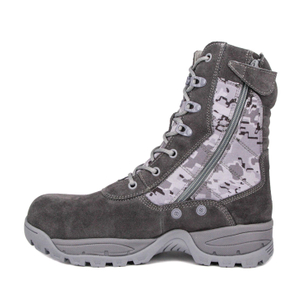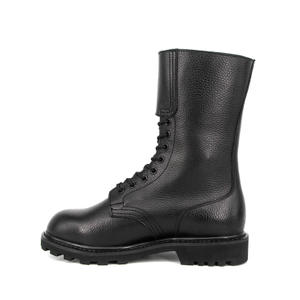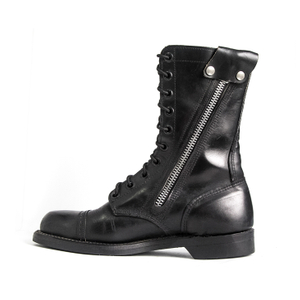Combat boots are more than just rugged footwear — they are a vital piece of gear for military personnel, outdoor enthusiasts, and fashion-forward individuals alike. Designed to withstand extreme conditions, provide ankle support, and offer superior traction, combat boots are a staple in army and tactical gear collections worldwide. Whether you're a soldier relying on boots during deployment, a hiker traversing challenging terrain, or a civilian embracing the military aesthetic, properly maintaining your boots ensures durability, longevity, and peak performance.
With the growing popularity of combat boots in both practical and fashion contexts, it's essential to understand the correct methods for cleaning and caring for different materials — such as full-grain leather, suede, and synthetic fabrics. Regular upkeep not only preserves the boots' appearance but also maintains the structural integrity critical for military use.
In this comprehensive guide, we'll analyze cleaning techniques, compare products, and provide maintenance strategies tailored to various types of combat boots. Whether you're dealing with mud from the field or oil stains from city streets, these expert tips will help you keep your combat boots in top shape.
How to Clean Full Leather Combat Boots
Full-leather combat boots are known for their durability and classic military aesthetic. Proper cleaning is essential to prevent cracking, maintain waterproofing, and keep them inspection-ready.
Step-by-Step Cleaning Process
Remove laces and insoles
Taking out the laces and insoles allows for thorough cleaning and prevents damage.
Brush off dirt
Use a soft-bristled brush to remove dried mud and dust. A toothbrush works well for tight seams.
Clean with leather cleaner or saddle soap
Mix a small amount of saddle soap with warm water, apply it with a cloth, and gently scrub. Avoid soaking the leather.
Wipe and dry
Use a damp cloth to wipe off soap residue. Let the boots air dry naturally — never use heat.
Condition the leather
Apply a leather conditioner or mink oil to keep the leather supple. This is especially important for army boots exposed to extreme environments.
Polish (optional)
For a high-shine finish, especially useful for military formal events, use a quality boot polish in a matching color.
How to Clean Suede Combat Boots
Suede combat boots offer a rugged yet stylish alternative to traditional leather boots. However, suede is more delicate and requires special care to avoid permanent damage.
Cleaning Process for Suede
Brush gently with suede brush
Use a suede-specific brush to remove loose dirt and restore the nap. Always brush in one direction.
Use an eraser for stains
A suede eraser or even a clean rubber eraser can lift surface stains and scuffs.
Spot clean with white vinegar
Dampen a cloth with white vinegar or rubbing alcohol (not water), dab the stained area, and let it dry.
Restore the nap
Once dry, gently brush the suede to restore its texture.
Apply suede protector
Use a suede-specific waterproofing spray to protect against future stains and moisture.
How to Remove Oil Stains from Suede Boots
Oil stains can be particularly challenging on suede combat boots, but with the right techniques, they can often be lifted completely.
Oil Removal Method
Blot the stain
Use a paper towel to gently blot (not rub) the fresh oil. Do this as quickly as possible to prevent absorption.
Apply cornstarch or talcum powder
Generously cover the stain with powder and let it sit overnight to absorb the oil.
Brush off residue
After 8–12 hours, use a suede brush to remove the powder.
Repeat if needed
For deeper stains, repeat the process or use a suede cleaner with degreasing properties.
Suede vs. Leather: Oil Stain Resistance
| Material | Oil Absorption Rate | Ease of Cleaning | Durability with Oil Exposure |
| Suede | High | Moderate | Low |
| Full Leather | Medium | High | High |
How to Clean Synthetic Combat Boots
Synthetic combat boots, often made from nylon or PVC, are popular in modern military usage due to their lightweight build and affordability. Cleaning these boots is straightforward but requires specific steps to maintain their tactical integrity.
Cleaning Process
Remove laces and insoles
This allows for a complete and effective clean.
Brush off debris
Use a stiff nylon brush to remove dirt from seams and fabric overlays.
Scrub with mild soap and water
Mix a few drops of dish soap with warm water. Use a cloth or sponge to clean all surfaces. Avoid harsh detergents that can degrade synthetic materials.
Rinse and dry
Use a clean damp cloth to wipe off soap, then air dry.
Apply synthetic boot protector
Helps repel water and dirt, extending the life of your combat boots.
Routine Boot Cleaning & Maintenance Tips
Proper maintenance is essential for all types of combat boots, whether used in military operations or fashion contexts. Here are general tips that prolong boot life and performance.
Weekly Maintenance Checklist
Inspect your boots for damage or loose stitching.
Clean off mud and debris before it hardens.
Store boots in a dry, ventilated area to prevent mold.
Use boot trees to retain shape.
Apply waterproofing spray monthly, especially before rainy seasons.
Monthly Deep Clean Comparison
| Boot Type | Recommended Deep Clean Frequency | Special Product Needed | Dry Time |
| Full Leather | Once a month | Conditioner & Polish | 12–24 hrs |
| Suede | Every 3–4 weeks | Suede Protector | 6–12 hrs |
| Synthetic | Monthly | Fabric Cleaner | 6–8 hrs |
Seasonal Care Tips
Winter: Use waterproofing and salt-resistant sprays.
Summer: Store in shaded areas to avoid UV damage.
Rainy seasons: Dry boots thoroughly to prevent mold.
Conclusion
Caring for your combat boots is not just about preserving their appearance — it's about ensuring they remain functional, comfortable, and reliable. Whether you wear them in military operations, for outdoor adventure, or as part of a rugged fashion statement, proper maintenance is non-negotiable.
From the resilient full-leather army boots to the more delicate suede and the ultra-practical synthetic types, each material demands a specialized approach. Regular cleaning, conditioning, and protective treatments will ensure your boots are always ready for whatever challenge lies ahead.
With this guide, you're equipped with expert-level knowledge, product comparisons, and practical strategies to care for your combat boots like a pro. Whether you're preparing for a field mission or a city stroll, your boots will stand the test of time — and terrain.
FAQs
Q1: Can I wash my combat boots in a washing machine?
No. Especially for leather and suede combat boots, machine washing can cause irreparable damage. Synthetic boots may tolerate light machine washes but it's not recommended.
Q2: How often should I polish leather combat boots?
For military personnel, weekly polishing is standard. Civilians can do it bi-weekly depending on wear.
Q3: How do I waterproof suede combat boots?
Use a specialized suede waterproofing spray. Never use wax or oil-based products.
Q4: What's the best way to store combat boots long-term?
Store in a cool, dry place with boot trees or stuffed with newspaper. Keep away from direct sunlight.
Q5: Are synthetic combat boots as durable as leather?
Synthetic boots are lighter and more affordable but typically less durable than full-grain leather boots used in the army.
Q6: What's the biggest mistake people make when cleaning boots?
Using the wrong cleaner for the material — for example, using water on suede or harsh soap on leather.
Q7: Can I use household products to clean my combat boots?
A: Yes, mild dish soap, vinegar, and baking soda can be used for basic cleaning. However, specialty products offer better results.























